child restraint MITSUBISHI ASX 2017 (in English) User Guide
[x] Cancel search | Manufacturer: MITSUBISHI, Model Year: 2017, Model line: ASX, Model: MITSUBISHI ASX 2017Pages: 458, PDF Size: 22.98 MB
Page 83 of 458

WARNINGlWhen installing a child restraint system,
refer to the instructions provided by themanufacturer of the restraint system.Failure to do so can result in severe or fa-tal injury to the child.
l After installation, push and pull the child
restraint system back and forth, and side to side, to see that it is properly secured.
If the child restraint system is not instal-
led securely, it may cause injury to the
child or other occupants in the case of ac- cident or sudden stops.
l When the child restraint system is not in
use, keep your child restraint system se-
cured with the seat belt or remove it from the vehicle in order to prevent it from be- ing thrown around inside the vehicle dur-
ing an accident.
Depending on the seating position in the
vehicle and the child restraint system
that you have, the child restraint can be attached using one of the following two
locations: • To the lower anchorage in the rear
seat ONLY if the child restraint has
ISOFIX mountings (See page 4-18).
• To the seat belt (See pages 4-09,
4-23).
Older children
E00406700277
Children who have outgrown the child re-
straint system should be seated in the rear
seat and wear combination lap shoulder belt.
The lap portion of the belt should be snug and positioned low on the abdomen so that it
is below the top of the hip-bone. Otherwise, the belt could intrude into the child’s abdo-
men during an accident and cause injury.
Child restraint
4-17OGAE17E2Seat and seat belts4
Page 84 of 458

Suitability for various ISOFIX positions
E00411401934Mass groupSize classFixtureVehicle ISOFIX positionsRear outboardCarrycotFISO/L1XGISO/L2X0- Up to 10 kg
(0-9 months)EISO/R1X0+- Up to 13 kg
(0-2 years)EISO/R1IL* 1DISO/R2XCISO/R3XI- 9 to 18 kg
(9 months-4 years)DISO/R2XCISO/R3IL* 2BISO/F2IUFB1ISO/F2XIUF, IL* 3AISO/F3IUF, IL*4II & III- 15 to 36 kg
(4-12 years) XCAUTIONl When installing a child restraint system, remove the head restraint from the seat.
Child restraint
4-18OGAE17E2Seat and seat belts4
Page 85 of 458
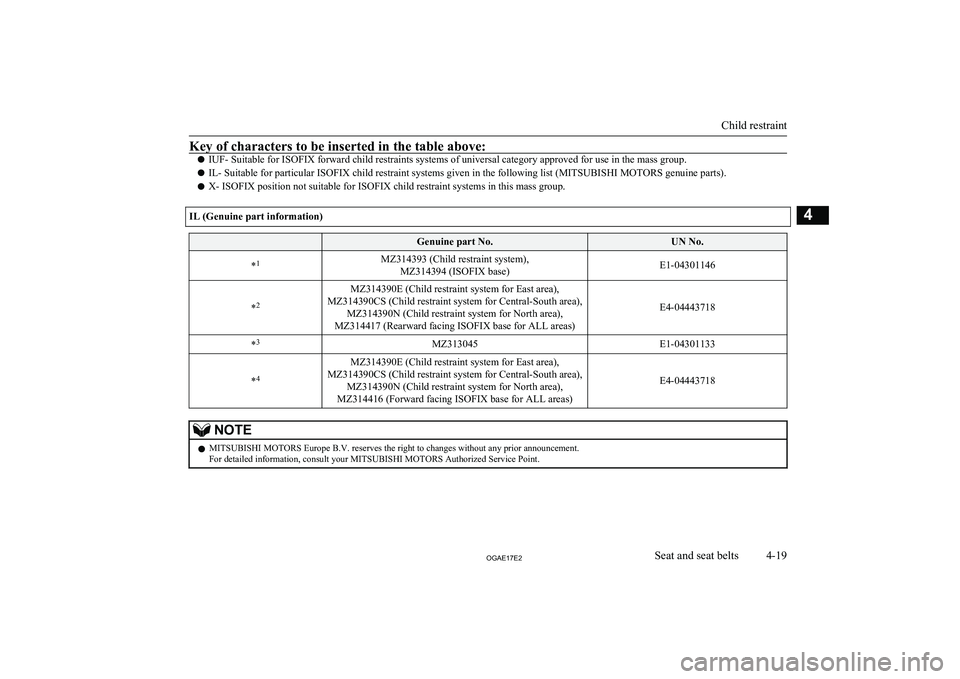
Key of characters to be inserted in the table above:
lIUF- Suitable for ISOFIX forward child restraints systems of universal category approved for use in the mass group.
l IL- Suitable for particular ISOFIX child restraint systems given in the following list (MITSUBISHI MOTORS genuine parts).
l X- ISOFIX position not suitable for ISOFIX child restraint systems in this mass group.IL (Genuine part information) Genuine part No.UN No.*1MZ314393 (Child restraint system),
MZ314394 (ISOFIX base)E1-04301146
*2
MZ314390E (Child restraint system for East area),
MZ314390CS (Child restraint system for Central-South area), MZ314390N (Child restraint system for North area),
MZ314417 (Rearward facing ISOFIX base for ALL areas)
E4-04443718
* 3MZ313045E1-04301133
*4
MZ314390E (Child restraint system for East area),
MZ314390CS (Child restraint system for Central-South area), MZ314390N (Child restraint system for North area),
MZ314416 (Forward facing ISOFIX base for ALL areas)
E4-04443718
NOTEl MITSUBISHI MOTORS Europe B.V. reserves the right to changes without any prior announcement.
For detailed information, consult your MITSUBISHI MOTORS Authorized Service Point.
Child restraint
4-19OGAE17E2Seat and seat belts4
Page 86 of 458
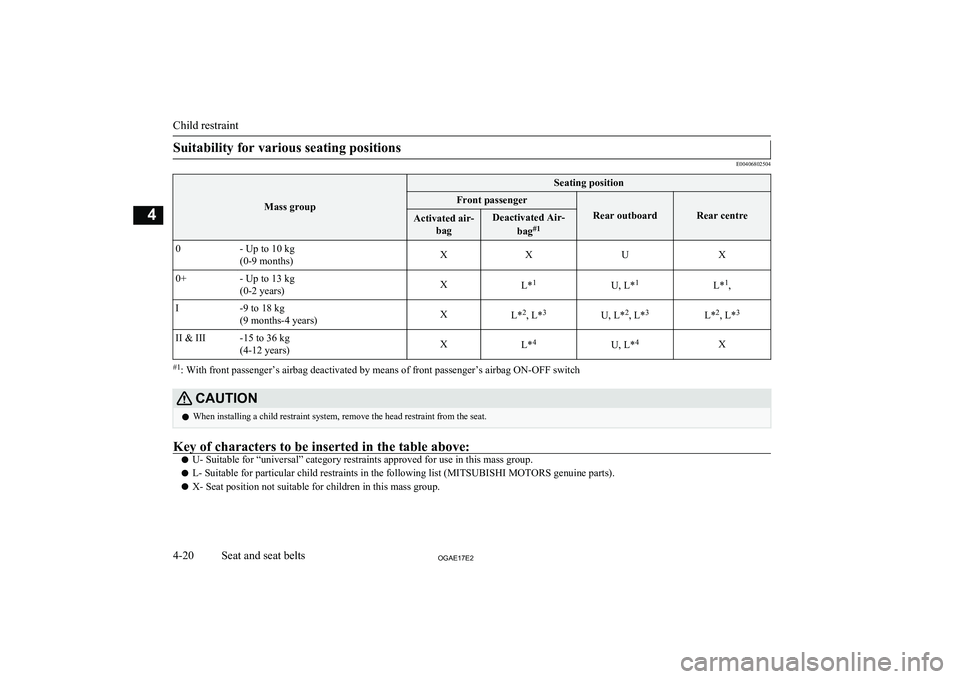
Suitability for various seating positions
E00406802504Mass group
Seating positionFront passenger
Rear outboardRear centre
Activated air-bagDeactivated Air-
bag#10- Up to 10 kg
(0-9 months)XXUX0+- Up to 13 kg
(0-2 years)XL* 1U, L* 1L*1
,I-9 to 18 kg
(9 months-4 years)XL* 2
, L* 3U, L* 2
, L* 3L*2
, L* 3II & III-15 to 36 kg
(4-12 years)XL* 4U, L* 4X
#1
: With front passenger’s airbag deactivated by means of front passenger’s airbag ON-OFF switch
CAUTIONl When installing a child restraint system, remove the head restraint from the seat.Key of characters to be inserted in the table above:
l
U- Suitable for “universal” category restraints approved for use in this mass group.
l L- Suitable for particular child restraints in the following list (MITSUBISHI MOTORS genuine parts).
l X- Seat position not suitable for children in this mass group.
Child restraint
4-20OGAE17E2Seat and seat belts4
Page 87 of 458

L (Genuine part information) Genuine part No.UN No.*1MZ314393E1-04301146*2MZ313045E1-04301133*3MZ314390E (for East area),
MZ314390CS (for Central-South area), MZ314390N (for North area)E4-03443416*4MZ314250E1-04301169NOTEl
There is no applicable MITSUBISHI MOTORS Genuine Parts to the Mass Group “0-Up to 10 kg”.
MITSUBISHI MOTORS Europe B.V. reserves the right to changes without any prior announcement.
For further information, please contact a MITSUBISHI MOTORS Authorized Service Point.
Child restraint
4-21OGAE17E2Seat and seat belts4
Page 88 of 458

Installing a child restraint sys-tem to the lower anchorage (ISOFIX child restraint mount-ings) and tether anchorage
E00406901986
Lower anchorage location
Your vehicle’s rear seat is fitted with lower
anchorages for attaching a child restraint sys- tem with ISOFIX mountings.
Tether anchorage locations
There are 2 child restraint anchorage points located on the back of the rear seatbacks.
These are for fastening the child restraint tether straps to the 2 rear seat seating posi-
tions.
WARNINGl Child restraint anchorages are designed
to withstand only those loads imposed by
correctly fitted child restraints. Under no circumstances are they to be used for adult seat belts, harnesses, or for attach-
ing other items or equipment to the vehi- cle.Child restraint system with
ISOFIX mountings
The child restraint system is designed only
for seats that incorporate lower anchorages.
Retain the child restraint system using the lower anchorages.
It is not necessary to retain the child restraint
system using the vehicle’s seat belts.
A- Child restraint system connectors
To install
1. Remove any foreign material in or
around the connectors and ensure the ve- hicle seat belt is in its normal storage po-
sition.
2. Remove the head restraint from the loca-
tion in which you wish to install a child
restraint.
Refer to “Head restraints” on page 4-07.
Child restraint
4-22OGAE17E2Seat and seat belts4
Page 89 of 458
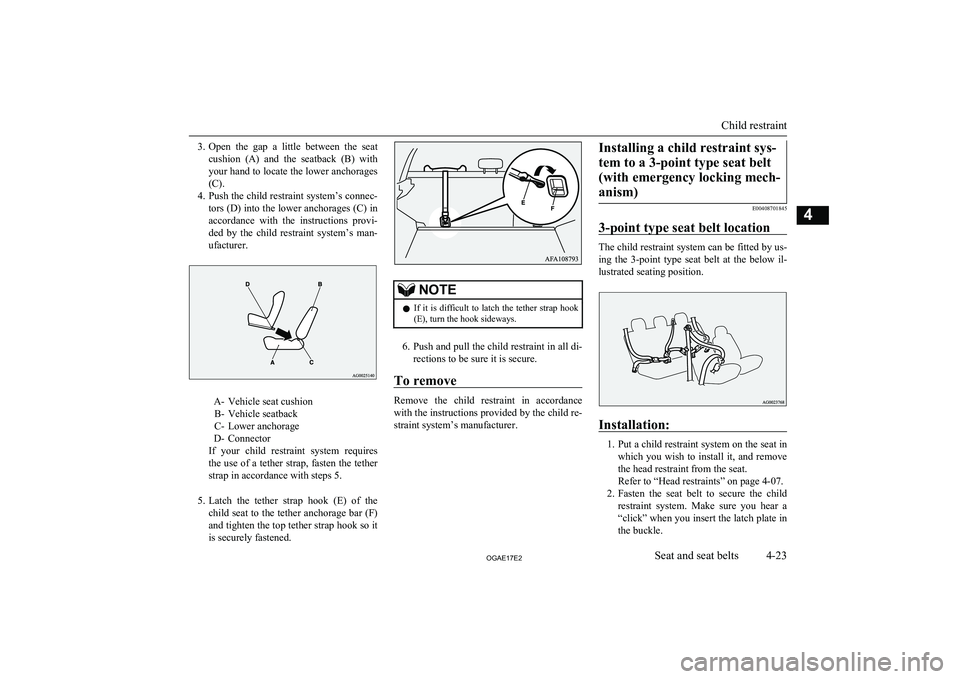
3.Open the gap a little between the seat
cushion (A) and the seatback (B) with your hand to locate the lower anchorages
(C).
4. Push the child restraint system’s connec-
tors (D) into the lower anchorages (C) in accordance with the instructions provi-
ded by the child restraint system’s man-
ufacturer.
A- Vehicle seat cushion B- Vehicle seatback
C- Lower anchorage
D- Connector
If your child restraint system requires
the use of a tether strap, fasten the tether strap in accordance with steps 5.
5. Latch the tether strap hook (E) of the
child seat to the tether anchorage bar (F)
and tighten the top tether strap hook so it is securely fastened.
NOTEl If it is difficult to latch the tether strap hook
(E), turn the hook sideways.
6. Push and pull the child restraint in all di-
rections to be sure it is secure.
To remove
Remove the child restraint in accordance
with the instructions provided by the child re-
straint system’s manufacturer.
Installing a child restraint sys-
tem to a 3-point type seat belt(with emergency locking mech- anism)
E00408701845
3-point type seat belt location
The child restraint system can be fitted by us- ing the 3-point type seat belt at the below il-
lustrated seating position.
Installation:
1. Put a child restraint system on the seat in
which you wish to install it, and remove
the head restraint from the seat.
Refer to “Head restraints” on page 4-07.
2. Fasten the seat belt to secure the child
restraint system. Make sure you hear a “click” when you insert the latch plate in
the buckle.
Child restraint
4-23OGAE17E2Seat and seat belts4
Page 90 of 458
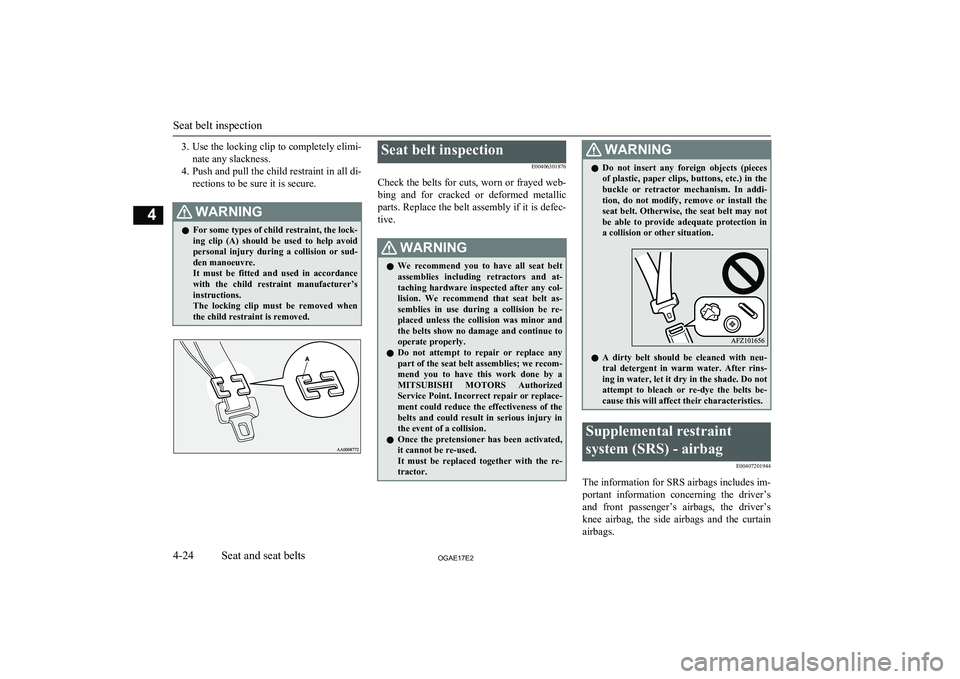
3.Use the locking clip to completely elimi-
nate any slackness.
4. Push and pull the child restraint in all di-
rections to be sure it is secure.WARNINGl For some types of child restraint, the lock-
ing clip (A) should be used to help avoid personal injury during a collision or sud-den manoeuvre.
It must be fitted and used in accordance
with the child restraint manufacturer’s instructions.
The locking clip must be removed when the child restraint is removed.Seat belt inspection
E00406301876
Check the belts for cuts, worn or frayed web- bing and for cracked or deformed metallic
parts. Replace the belt assembly if it is defec-
tive.WARNINGl We recommend you to have all seat belt
assemblies including retractors and at-
taching hardware inspected after any col- lision. We recommend that seat belt as-
semblies in use during a collision be re- placed unless the collision was minor and
the belts show no damage and continue to operate properly.
l Do not attempt to repair or replace any
part of the seat belt assemblies; we recom-
mend you to have this work done by a MITSUBISHI MOTORS Authorized
Service Point. Incorrect repair or replace-
ment could reduce the effectiveness of the
belts and could result in serious injury in the event of a collision.
l Once the pretensioner has been activated,
it cannot be re-used.
It must be replaced together with the re-
tractor.WARNINGl Do not insert any foreign objects (pieces
of plastic, paper clips, buttons, etc.) in the
buckle or retractor mechanism. In addi- tion, do not modify, remove or install the
seat belt. Otherwise, the seat belt may not be able to provide adequate protection in a collision or other situation.
l A dirty belt should be cleaned with neu-
tral detergent in warm water. After rins-
ing in water, let it dry in the shade. Do not
attempt to bleach or re-dye the belts be-
cause this will affect their characteristics.
Supplemental restraint
system (SRS) - airbag E00407201944
The information for SRS airbags includes im-
portant information concerning the driver’s and front passenger’s airbags, the driver’s knee airbag, the side airbags and the curtain
airbags.
Seat belt inspection
4-24OGAE17E2Seat and seat belts4
Page 92 of 458
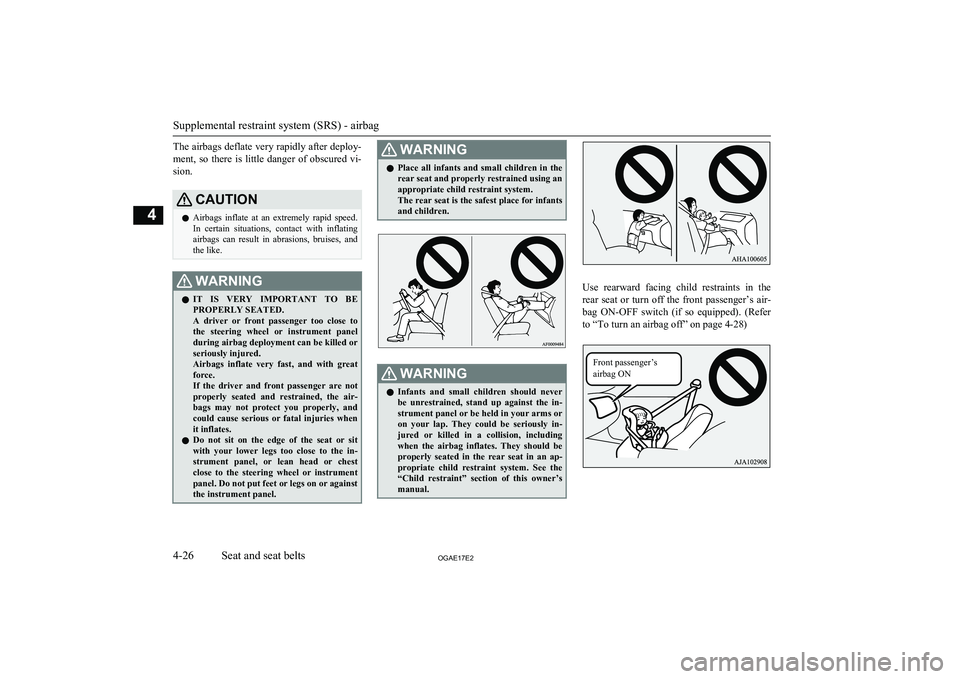
The airbags deflate very rapidly after deploy-
ment, so there is little danger of obscured vi- sion.CAUTIONl Airbags inflate at an extremely rapid speed.
In certain situations, contact with inflating airbags can result in abrasions, bruises, and the like.WARNINGl IT IS VERY IMPORTANT TO BE
PROPERLY SEATED.
A driver or front passenger too close to the steering wheel or instrument panel
during airbag deployment can be killed or seriously injured.
Airbags inflate very fast, and with great force.
If the driver and front passenger are not
properly seated and restrained, the air-
bags may not protect you properly, and could cause serious or fatal injuries whenit inflates.
l Do not sit on the edge of the seat or sit
with your lower legs too close to the in-
strument panel, or lean head or chest close to the steering wheel or instrument panel. Do not put feet or legs on or againstthe instrument panel.WARNINGl Place all infants and small children in the
rear seat and properly restrained using an
appropriate child restraint system.
The rear seat is the safest place for infants
and children.WARNINGl Infants and small children should never
be unrestrained, stand up against the in-strument panel or be held in your arms or on your lap. They could be seriously in-jured or killed in a collision, including when the airbag inflates. They should be
properly seated in the rear seat in an ap- propriate child restraint system. See the
“Child restraint” section of this owner’s
manual.
Use rearward facing child restraints in the
rear seat or turn off the front passenger’s air- bag ON-OFF switch (if so equipped). (Refer
to “To turn an airbag off” on page 4-28)
Supplemental restraint system (SRS) - airbag
4-26OGAE17E2Seat and seat belts4 Front passenger’s
airbag ON
Page 93 of 458

WARNINGlA REARWARD FACING CHILD RE-
STRAINT must NOT be used in the front passenger seat if the front passenger’s air-
bag has not been deactivated. The force of an inflating airbag could kill or cause se-
rious injuries to the child.
A rearward facing child restraint should be used in the rear seat.
l A FORWARD FACING CHILD RE-
STRAINT should be used in the rear seat
whenever possible; if they must be used in the front passenger seat, turn off the front
passenger’s airbag ON-OFF switch. Fail- ure to do so could kill or cause serious in-
juries to the child.
l Older children should be seated in the
rear seat, properly wearing the seat belt,with an appropriate booster seat if nee- ded.Caution for installing the child
restraint on vehicles with a front passenger airbag
E00408802175
The label shown here is attached on vehicles
with a front passenger airbag.
WARNINGl Extreme Hazard!
NEVER use a rearward facing child re- straint on a seat protected by an ACTIVEAIRBAG in front of it, DEATH or SERI- OUS INJURY to the CHILD can occur.NOTEl The labels may be in different positions de-
pending on the vehicle model.Front passenger’s airbag ON-
OFF switch*
E00410100285
The front passenger’s airbag ON-OFF switch
can be used to disable the front passenger’s airbag. If you have a child restraint system
that cannot be fitted to any seat other than the front passenger seat, be sure to turn OFF the front passenger’s airbag ON-OFF switch be-
fore using it.
(Refer to “To turn an airbag off” on page
4-28.)
The front passenger’s airbag ON-OFF switch
is located in the glove box.Supplemental restraint system (SRS) - airbag
4-27OGAE17E2Seat and seat belts4